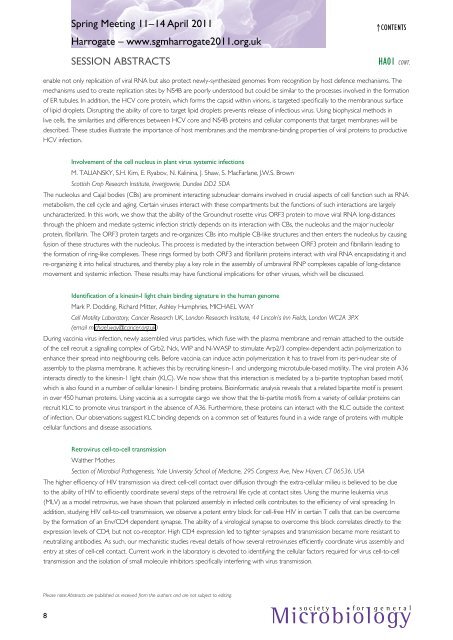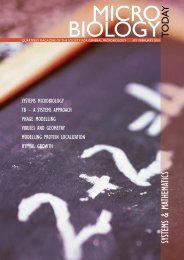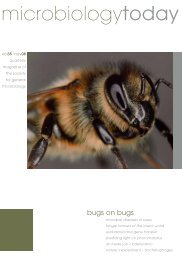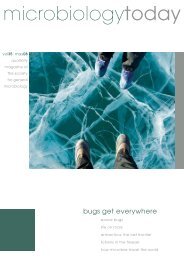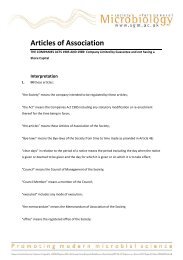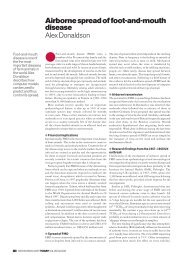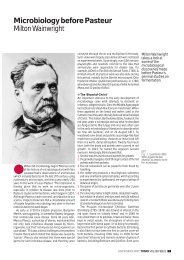Spring Conference 2011 - Society for General Microbiology
Spring Conference 2011 - Society for General Microbiology
Spring Conference 2011 - Society for General Microbiology
Create successful ePaper yourself
Turn your PDF publications into a flip-book with our unique Google optimized e-Paper software.
Please note: Abstracts are published as received from the authors and are not subject to editing.<br />
8<br />
<strong>Spring</strong> Meeting 11–14 April <strong>2011</strong><br />
Harrogate – www.sgmharrogate<strong>2011</strong>.org.uk<br />
SESSION AbSTrACTS<br />
↑Contents<br />
HA01 Cont.<br />
enable not only replication of viral rNA but also protect newly-synthesized genomes from recognition by host defence mechanisms. The<br />
mechanisms used to create replication sites by NS4B are poorly understood but could be similar to the processes involved in the <strong>for</strong>mation<br />
of Er tubules. in addition, the HCV core protein, which <strong>for</strong>ms the capsid within virions, is targeted specifically to the membranous surface<br />
of lipid droplets. Disrupting the ability of core to target lipid droplets prevents release of infectious virus. using biophysical methods in<br />
live cells, the similarities and differences between HCV core and NS4B proteins and cellular components that target membranes will be<br />
described. These studies illustrate the importance of host membranes and the membrane-binding properties of viral proteins to productive<br />
HCV infection.<br />
Involvement of the cell nucleus in plant virus systemic infections<br />
M. TAliANSKY, S.H. Kim, E. ryabov, N. Kalinina, J. Shaw, S. MacFarlane, J.W.S. Brown<br />
Scottish Crop Research Institute, Invergowrie, Dundee DD2 5DA<br />
The nucleolus and Cajal bodies (CBs) are prominent interacting subnuclear domains involved in crucial aspects of cell function such as rNA<br />
metabolism, the cell cycle and aging. Certain viruses interact with these compartments but the functions of such interactions are largely<br />
uncharacterized. in this work, we show that the ability of the Groundnut rosette virus OrF3 protein to move viral rNA long-distances<br />
through the phloem and mediate systemic infection strictly depends on its interaction with CBs, the nucleolus and the major nucleolar<br />
protein, fibrillarin. The OrF3 protein targets and re-organizes CBs into multiple CB-like structures and then enters the nucleolus by causing<br />
fusion of these structures with the nucleolus. This process is mediated by the interaction between OrF3 protein and fibrillarin leading to<br />
the <strong>for</strong>mation of ring-like complexes. These rings <strong>for</strong>med by both OrF3 and fibrillarin proteins interact with viral rNA encapsidating it and<br />
re-organizing it into helical structures, and thereby play a key role in the assembly of umbraviral rNP complexes capable of long-distance<br />
movement and systemic infection. These results may have functional implications <strong>for</strong> other viruses, which will be discussed.<br />
Identification of a kinesin-I light chain binding signature in the human genome<br />
Mark P. Dodding, richard Mitter, Ashley Humphries, MiCHAEl WAY<br />
Cell Motility Laboratory, Cancer Research UK, London Research Institute, 44 Lincoln’s Inn Fields, London WC2A 3PX<br />
(email michael.way@cancer.org.uk)<br />
During vaccinia virus infection, newly assembled virus particles, which fuse with the plasma membrane and remain attached to the outside<br />
of the cell recruit a signalling complex of Grb2, Nck, WiP and N-WASP to stimulate Arp2/3 complex-dependent actin polymerization to<br />
enhance their spread into neighbouring cells. Be<strong>for</strong>e vaccinia can induce actin polymerization it has to travel from its peri-nuclear site of<br />
assembly to the plasma membrane. it achieves this by recruiting kinesin-1 and undergoing microtubule-based motility. The viral protein A36<br />
interacts directly to the kinesin-1 light chain (KlC). We now show that this interaction is mediated by a bi-partite tryptophan based motif,<br />
which is also found in a number of cellular kinesin-1 binding proteins. Bioin<strong>for</strong>matic analysis reveals that a related bipartite motif is present<br />
in over 450 human proteins. using vaccinia as a surrogate cargo we show that the bi-partite motifs from a variety of cellular proteins can<br />
recruit KlC to promote virus transport in the absence of A36. Furthermore, these proteins can interact with the KlC outside the context<br />
of infection. Our observations suggest KlC binding depends on a common set of features found in a wide range of proteins with multiple<br />
cellular functions and disease associations.<br />
retrovirus cell-to-cell transmission<br />
Walther Mothes<br />
Section of Microbial Pathogenesis, Yale University School of Medicine, 295 Congress Ave, New Haven, CT 06536, USA<br />
The higher efficiency of HiV transmission via direct cell-cell contact over diffusion through the extra-cellular milieu is believed to be due<br />
to the ability of HiV to efficiently coordinate several steps of the retroviral life cycle at contact sites. using the murine leukemia virus<br />
(MlV) as a model retrovirus, we have shown that polarized assembly in infected cells contributes to the efficiency of viral spreading. in<br />
addition, studying HiV cell-to-cell transmission, we observe a potent entry block <strong>for</strong> cell-free HiV in certain T cells that can be overcome<br />
by the <strong>for</strong>mation of an Env/CD4 dependent synapse. The ability of a virological synapse to overcome this block correlates directly to the<br />
expression levels of CD4, but not co-receptor. High CD4 expression led to tighter synapses and transmission became more resistant to<br />
neutralizing antibodies. As such, our mechanistic studies reveal details of how several retroviruses efficiently coordinate virus assembly and<br />
entry at sites of cell-cell contact. Current work in the laboratory is devoted to identifying the cellular factors required <strong>for</strong> virus cell-to-cell<br />
transmission and the isolation of small molecule inhibitors specifically interfering with virus transmission.<br />
s o c i e t y f o r g e n e r a l<br />
<strong>Microbiology</strong>


